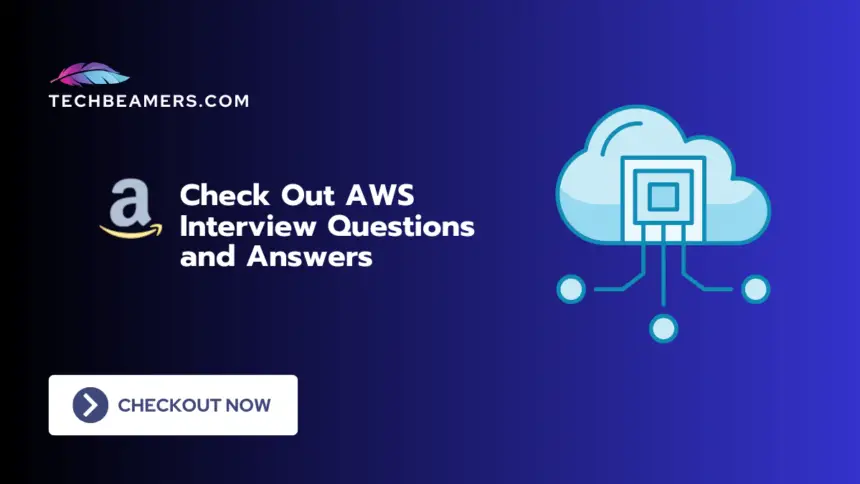We have brought you 25 AWS interview questions with simple answers. We hope you’ll easily grasp each of them.
25 AWS Interview Questions and Answers
The below questions set covers a wide range of AWS interview questions. We hope these will be useful for you in the future.
1. Basic AWS Concepts
Question 1: What is AWS?
Answer: AWS stands for Amazon Web Services. It’s a comprehensive cloud computing platform provided by Amazon that offers a variety of services, including computing power, storage, databases, machine learning, analytics, and more.
Question 2: What is S3?
Answer: Simple Storage Service (S3) is a scalable object storage service in AWS, designed to store and retrieve any amount of data from anywhere on the web.
Question 3: Explain EC2.
Answer: Elastic Compute Cloud (EC2) is a virtual server in AWS, allowing users to run applications and scale capacity easily. It’s like having your computer in the cloud.
2. Compute Services
Question 4: What is the difference between EC2 and Lambda?
Answer: EC2 provides virtual servers, while Lambda is a serverless computing service. With Lambda, you only pay for the compute time your code consumes.
Question 5: How do you choose the right EC2 instance type?
Answer: Consider factors like CPU, memory, storage, and network performance requirements. AWS provides instance types optimized for different use cases.
3. Networking
Question 6: Explain VPC.
Answer: Virtual Private Cloud (VPC) is a virtual network dedicated to your AWS account. It allows you to launch AWS resources in a defined virtual network.
Question 7: What is a subnet?
Answer: A subnet is a range of IP addresses in your VPC. It helps in organizing resources and controlling traffic between them.
4. Storage Services
Question 8: How is EBS different from S3?
Answer: Amazon Elastic Block Store (EBS) provides block-level storage for EC2 instances, while S3 is object storage for the web. EBS is commonly used for databases and file systems.
Question 9: What is the use of Amazon Glacier?
Answer: Amazon Glacier is a low-cost storage service for archiving and long-term backup. It’s suitable for data that is infrequently accessed.
5. Database Services
Question 10: What is RDS?
Answer: Amazon Relational Database Service (RDS) is a managed database service that supports various database engines like MySQL, PostgreSQL, Oracle, and more.
Question 11: Explain DynamoDB.
Answer: DynamoDB is a NoSQL database service fully managed by AWS. It offers swift and consistent performance with effortless scalability.
6. Security
Question 12: How can you secure data at rest in S3?
Answer: Use S3 bucket policies and access control lists (ACLs) to manage permissions, and enable server-side encryption using AWS Key Management Service (KMS).
Question 13: What is AWS IAM?
Answer: AWS Identity and Access Management (IAM) is a service that helps securely control access to AWS resources. It enables the creation and management of AWS users and groups.
7. Monitoring and Logging
Question 14: What is CloudWatch?
Answer: Amazon CloudWatch is a monitoring service that provides data and actionable insights for AWS resources. It collects and tracks metrics, monitors logs, and sets alarms.
Question 15: How can you troubleshoot performance issues in an application hosted on AWS?
Answer: Use CloudWatch for monitoring, AWS Config for resource inventory, and AWS CloudTrail for auditing. Utilize these services to identify and resolve performance bottlenecks.
8. Automation and Orchestration
Question 16: What is AWS Lambda?
Answer: AWS Lambda is a serverless computing service that lets you run your code without provisioning or managing servers. It automatically scales and manages the compute resources.
Question 17: Explain AWS CloudFormation.
Answer: AWS CloudFormation is a service that allows you to define and provision AWS infrastructure as code. It helps in automating the deployment and management of resources.
9. Application Integration
Question 18: What is Amazon Simple Queue Service (SQS)?
Answer: Amazon SQS is a managed service offering to enable message queuing. It helps separate and scale microservices, supporting smooth operations for interconnected systems and serverless applications.
Question 19: How does AWS Step Functions work?
Answer: AWS Step Functions serves as a serverless orchestrator, streamlining the arrangement of AWS services and functions. It helps easily organize and connect different parts of important business applications without any fuss.
10. Pricing
Question 20: How does AWS pricing work?
Answer: AWS uses a pay-as-you-go model, where you pay only for the resources you consume. Pricing varies based on the services used, region, and usage patterns.
Question 21: What is the AWS Free Tier?
Answer: The AWS Free Tier is a set of free, limited-use AWS resources available to new AWS customers for a specified period after signing up.
11. Disaster Recovery
Question 22: How can you implement disaster recovery in AWS?
Answer: Use services like Amazon S3 for data backup, create automated snapshots of EBS volumes, and utilize AWS Disaster Recovery services like AWS Backup and AWS Elastic Disaster Recovery.
Question 23: What is AWS Snowball?
Answer: AWS Snowball is a service that helps transfer large amounts of data into and out of AWS using physical storage appliances.
12. CDN and Content Delivery
Question 24: Explain Amazon CloudFront.
Answer: Amazon CloudFront is like a global delivery helper. It securely spreads out data, videos, apps, and APIs to users worldwide, ensuring everyone gets what they need quickly and safely.
Question 25: How can you optimize content delivery with CloudFront?
Answer: Set up caching, use compression, and leverage features like AWS Lambda@Edge to customize the content delivery process based on specific requirements.
The above AWS interview questions cover a range of AWS services and concepts, providing a comprehensive overview for interview preparation.









